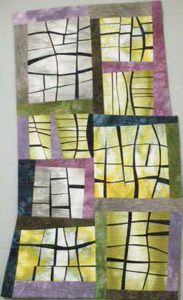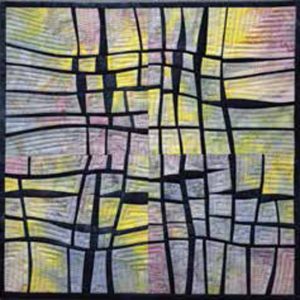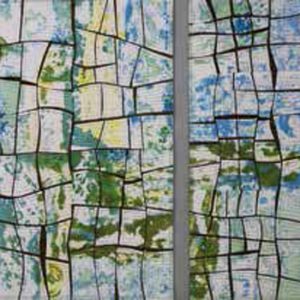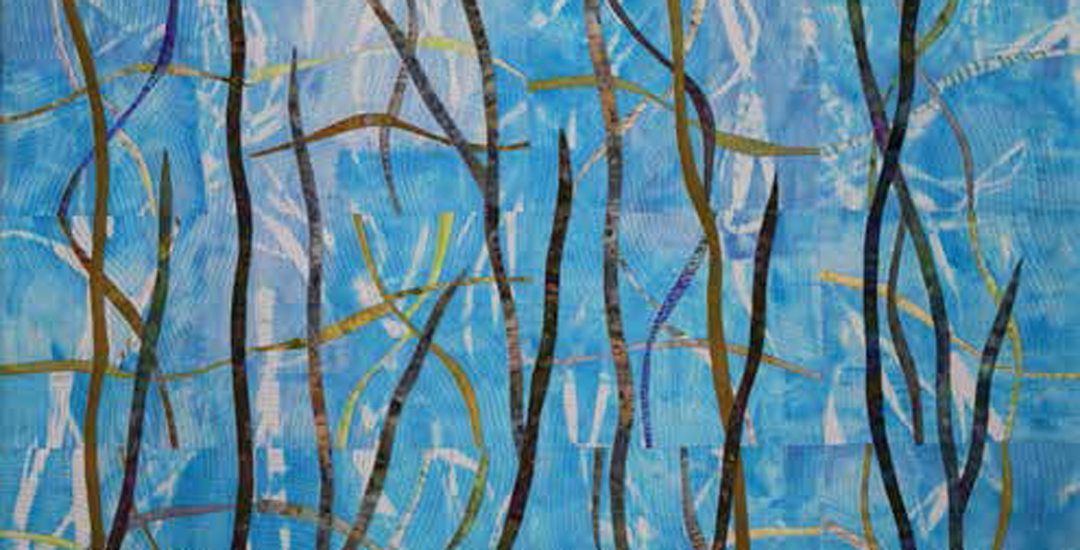I was always interested in articles about artists working in a series and the benefits to one’s art journey. Yet, I could never get past doing a couple of projects before I wanted to try another new exciting project or technique.
That all changed when I saw Elizabeth Barton’s houses with the light shining through the windows. I took a day to play at creating the panes of glass separated by the strips of wood. I was hooked. It was a wonderful combination of meditative cutting, sewing and pressing balanced by all the design choices I could make. Thick or thin lines, straight or curvy, fat or thin, big spaces, little spaces – the choices were limitless.
 Windowpanes
Windowpanes
Using three different background fabrics, I created blocks in three different scales. It was another challenge to pick the colours to use as sashing. What if I made blocks but didn’t use sashing? The light background seemed to bleed away so adding a border helped focus one’s eye on the intricate piecing. Grid Play #4 was the result.
 Beyond the Four Patch
Beyond the Four Patch
A call for a SAQA (Studio Art Quilt Associates) 12″ x 12″ auction piece led me to explore creating a secondary design by aligning the strips between four blocks in Beyond the Four Patch.
Cutting into my first deconstructed screen-printed fabric was my next step. I tried varying the scale of the blocks but combining them didn’t seem to work. It was only when I set aside the smaller scaled blocks that a diptych (any object with two flat plates which are a pair, often attached at a hinge) evolved.
 Diptych
Diptych
So far, I had used fabrics with high contrast – a light background and darker valued strips. This next piece had both light and dark values in the background so I had to use a medium value strip to obtain some contrast. Adding a border using the same colour as the strips helped to bring the focus back to the grid format. It resulted in a more subtle piece and is called Purple and Lime.
A small image of a painting by Russna Kaur, a local artist, reminded me of a quilt with a pieced background and layers of depth created through different values and sizes of lines. Her image led to more exploration of value. After I planned a scrappy background, I inserted strips of different values into each block adding to its depth. An overlaid grid of a darker value added more depth and is the name of that work.
A different colour way influenced my next piece, Evening Sky, and I realized my choice reflected the colours in the sky from photos I had been taking. Values in those colours were used in three layers of strips before adding strips and star shapes in a darker value.
A palette of various background fabrics, different colours and values of strips created more depth and texture in my next piece, Seven Lines. What a wonderful contrast to the dark straight lines overlaid at the end.
 Seven Lines
Seven Lines
Two tools have helped fine tune my use of value. Photocopying my fabric in black and white helped but now I use a black and white setting on my tablet to photograph my fabrics. For Underwater Dance, I was able to assign all the fabrics to their correct value pile without any changes so it feels exciting to know that I’m improving in my value choices. A piece of fabric that I screen printed using various blues and with grasses as a resist created some ready-made lines. I continued to explore using value to create depth in each of the blocks. Images of swimming underwater led to a variety of wavy grasses as the last layer.
A turquoise fabric treated with a flour resist and painted couldn’t be anything other than an iceberg with all its cracks and striations and cold colours. The inserted lines added more subtle cracks before adding the outline of an iceberg in all its grandeur. It was the 14th piece I created in this series.
 All of my pieces are first quilted in the ‘ditch’ of the strips then echo quilted, reinforcing the grid like designs I have created. I’m ready now to return to the simple one block unit, but on a larger scale. It’ll be a challenge as I won’t be able to use the less interesting blocks to complement other blocks but will need to rely on the one block working on its own.
All of my pieces are first quilted in the ‘ditch’ of the strips then echo quilted, reinforcing the grid like designs I have created. I’m ready now to return to the simple one block unit, but on a larger scale. It’ll be a challenge as I won’t be able to use the less interesting blocks to complement other blocks but will need to rely on the one block working on its own.
I started this journey in 2014 and am fascinated by the ideas I’ve generated along the way. I cannot believe I’m finally creating a series of works and the ideas are still rolling in. If you would like to see more images of my Evolution of a Line series, check out the Abstract section of my website where any images that aren’t included in this article can be found.
Karen Johnson is a member of Fibre Art Network (FAN) ) as well as Studio Art Quilt Associates and the Langley Quilters’ Guild. Visit her website.
Header image: Underwater Dancer


